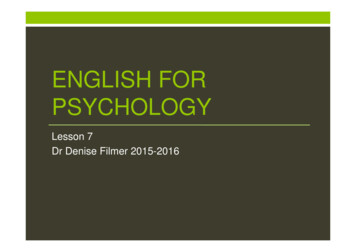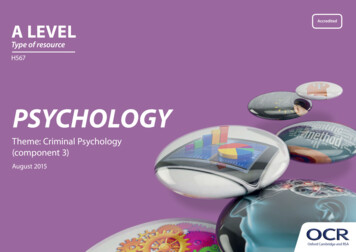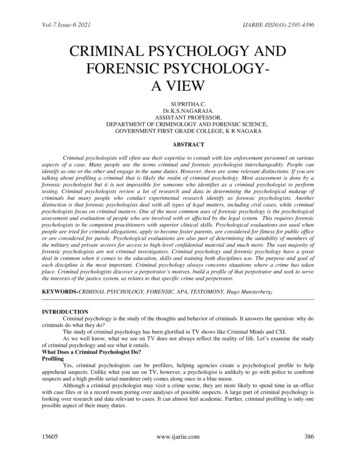
Transcription
ENGLISH FORPSYCHOLOGYLesson 7Dr Denise Filmer 2015-2016
TYPES OF DISORDERUnit 2 Clinical and abnormal psychology
Split Personality Split personality, called Dissociative identity disorder(DID), or multiple personality disorder (MPD). A mental disorder characterised by at least two distinctand enduring identities or dissociated personality statesthat alternately control a person’s behaviour. accompanied by memory impairment not explained byordinary forgetfulness. Diagnosis is difficult as there is comorbidity with othermental disorders.
Obsessive-Compulsive disorder(OCD) Is an anxiety disorder characterised by uneasiness,apprehension, fear, or worry, characterised by repetitivebehaviours aimed at reducing the associated anxiety. Symptoms include excessive washing or cleaning;repeated checking; extreme hoarding; preoccupation withsexual, violent, or religious thoughts; relationship-relatedobsessions; aversion to particular numbers; and nervousrituals, such as opening and closing a door a certainnumber of times before entering or leaving a room.
Mood disorder (1) Mood disorder is the term designating a group ofdiagnoses in the Diagnostic and Statistical Manual ofMental Disorders (DSM IV TR) classification system wherea disturbance in the person's mood is hypothesized to bethe main underlying feature. The classification is known asmood (affective) disorders in ICD 10. English psychiatristHenry Maudsley proposed an overarching category ofaffective disorder. The term was then replaced by mooddisorder, as the latter term refers to the underlying orlongitudinal emotional state, whereas the former refers tothe external expression observed by others.
Mood disorder (2) Two groups of mood disorders are broadly recognized;the division is based on whether the person has ever hada manic or hypomanic episode. Thus, there aredepressive disorders, of which the best-known and mostresearched is major depressive disorder (MDD)commonly called clinical depression or major depression,and bipolar disorder (BD), formerly known as manicdepression and characterized by intermittent episodes ofmania or hypomania, usually interlaced with depressiveepisodes. However, there are also forms of depression ofMDD and BD that are less severe and are known asdysthymic disorder (in relation to MDD) and cyclothymicdisorder (in relation to BD)
Pharmacotherapy is the treatment of disease through theadministration of drugs. As such, it isconsidered part of the larger category oftherapy
Electroconvulsive therapy Electroconvulsive therapy (ECT) is a medicaltreatment for severe mental illness in which asmall, carefully controlled amount of electricity isintroduced into the brain. This electricalstimulation, used in conjunction with anaesthesiaand muscle-relaxant medications, produces amild generalized seizure or convulsion. Whileused to treat a variety of psychiatric disorders, itis most effective in the treatment of severedepression, and provides the most rapid reliefcurrently available for this illness.
Manic depressive psychosis (1)Bipolar disorder, formerlyknown as manic depression,is a mood disorder thatcauses radical emotionalchanges and mood swings,from manic, restless highsto depressive, listless lows.Most bipolar individualsexperience alternatingepisodes of mania anddepression.
Manic depressive psychosis (2) Bipolar disorder is characterised by alternatingmanic episodes in which the individual feelsabnormally euphoric, optimistic and energetic,and depressive periods in which the individualfeels sad, hopeless, guilty, and sometimessuicidal. Manic or depressive periods may last fordays, weeks, or months and run the spectrumfrom mild to severe. These episodes may beseparated by periods of emotional stability inwhich the individual functions normally.
Manic depressive psychosis
Infinitely Polar Bear (teneramente folle) 2014Maya Forbes https://www.youtube.com/watch?v heHiFQuFWvo
Acting-Out Is the expression of unconscious feelings and fantasies inbehaviour; reacting to present situations as if they werethe original situation that gave rise to the feelings andfantasies. The expression of intrapsychic conflict or painful emotionthrough overt behaviour that is usually pathologic,defensive, and unconscious and that may be destructiveor dangerous. In controlled situations such aspsychodrama, Gestalt therapy or play therapy, suchbehaviour may be therapeutic in that it may serve toreveal to the patient the underlying conflict governing thebehaviour
ENGLISH FOREDUCATORSFacchinetti, R & Belladelli, A (2011). CEDAM: PadovaPerspectives on Psychology
Perspectives on PsychologyS. Freud A Passage from The Interpretation of Dreams (1899) The concept of “experience”J. Piaget A passage from The Child’s Conception of the World (1929-1960) The Stages of Mental DevelopmentJ. Bruner A passage from Actual Minds, Possible Worlds (1986) Language Learning/AcquisitionH. Gardner Frames of Mind (1983-2004) The concepts of mind/cognitive/cognitionA Biographical section (“All about .”) for each author
SigmundFreud:Theinterpretationof dreamsTranslated by JamesStracey (1899/1998) NewYork: Avon Books pp. 307308
The interpretation of dreams (1) Everyone who has received his certificateof matriculation after passing his finalexamination at school complains of thepersistence with which he is plagued byanxiety dreams in which he has failed, ormust go through his course again, etc.These are the ineradicable memories of thepunishments we suffered as children formisdeeds which we had committed.
The interpretation of dreams (2) When our student days are over it is nolonger our parents or teachers who see toour punishment; the inexorable chain ofcause and effect of later life has taken overour further education. Now we dream of ourexamination whenever we fear that we maybe punished by some unpleasant resultbecause we have done somethingcarelessly or wrongly, because we have notthe burden of responsibility.
The interpretation of dreams (3) For a further explanation of examinationdreams I have to thank a remark made by acolleague who had studied this subject,who once stated, in the course of ascientific discussion, that in his experiencethe examination dream occurred only to thepersons who had passed the examination,never to those who had been “ploughed”.
The interpretation of dreams (4) We have had increasing confirmation of the factthat the anxiety dream of examination occurswhen the dreamer is anticipating a responsibletask on the following day, with the possibility ofdisgrace; [he then recalls] an occasion in the paston which a great anxiety proved to have beenwithout real justification, having indeed beenrefuted by the outcome.
The interpretation of dreams (5) The examination which is regarded as aprotest against the dream (“but I amalready a doctor!”) would in reality be theconsolation offered by the dream, andshould, therefore, be worded as follows:“do not be afraid of the morrow; think of theanxiety which you felt before yourmatriculation, yet nothing happened tojustify it, for now you are a doctor.
Talking about a text The passage/text article is about/deals with . The article describes/outlines/defines/sumsup/refers to The author is mainly concerned with /interestedin At the beginning /At first /in the firstparagraphs /initially. The text then moves on to discuss The author examines/shows/analyses/focuses on In the end, finally/in conclusion
Reading comprehension Find the appropriate ending to each statement.1. Examination dreams a.usually occur to illiterate peopleb. never occur to illiterate peoplec.Always occur to people who failed an important exam inreal life.2.The initial text provides a.one possible explanation for exam-dreamsb.two possible explanations for exam dreamsc.no explanation for exam dreams
Reading comprehension (cont.)3. Freud’s colleague a.refuted Freud’s explanation for examination dreamsb.provided an alternative explanation for examination dreamsc.shared Freud’s explanation for examination dreams4. According to Freud, examination dreams are phenomena a.by which we punish ourselves when we have done something wrongb.by which we increase our self esteemc.that occur only when we are students5.According to his colleague, examination dreams are phenomena a.That occur only when we are studentsb.B. by which we punish ourselves when we have done somethingwrongc.That eventually increase our self esteem
ENGLISH FORPSYCHOLOGYLesson 8Dr Denise Filmer2015-16
All about Sigmund Freud (p 15)
FREUD’S EXAMINATIONDREAM
On the couch with Freud Have you ever had anexamination dream? Yes, I have. I often getthem. No, I haven’t Inever get them Is it a recurring dream? Yes it is. Whenever I haveto sit an exam, or undergosomething stressful likean interview, I have thisdream
On thecouch withFreud Can you rememberwhere you are andhow old you are inthe dream? Are thereany other knownpeople in the dream?No, I really can’t/yes,I can remember itvery well. It’s alwaysthe same. In mydream I am at my oldhigh schoolclassroom with myschools mates andmy maths teacher.I’m about seventeenyears old etc etc
On the couch with Freud How do you feel when you wakeup after having that kind ofdream? I feel stressed out/anxious/ agitated/desperate/ because Iknow it’s somethingI’ve already beenthrough but at thesame time relievedwhen I realise it wasjust a dream!
From Freud to PiagetSigmund Freud(1856-1939)The father of psychoanalysisHis system of ideas about theId,Ego and Super-Ego of themind is still employed bypsychologists in one form oranother.Jean Piaget1896-1980Swiss Psychologist, he was thefirst to make a systematic studyof the acquisition ofunderstanding in children. He isprobably the major figure in 20thcentury developmentalpsychology
JeanPiagetThe Child’sConceptionof the World(1929/1960)
Jean Piaget’s brief biography He was born on August the 9th 1896 in Switzerland. In 1907 he published his first paper on the Albino Sparrow species. He was only 10 years old.In 1918 he obtained a doctorate in zoology and he studiedpsychoanalysis.In 1920 he started studying children’s intelligence andthree years later, in 1923, the first of his nearly 60scholarly works was published.In 1929 he was appointed director of the InternationalBureau of Education. In 1955, he established a Centre forgenetic epistemology.He died in Geneva in 1980.
The Child’s Perception of the World(1929/1960) text book p.17 J. Piaget The child is a realist because he has not yet grasped thedistinction between subject and object and the internalnature of thought. Obviously, therefore, he will beconfronted by grave difficulties when he attempts toexplain the most subjective of phenomena – dreams.
Inquiring into children’s perception ofdreams The study of children’s conceptions as to thenature of dreams is thus of great interest andfrom a twofold point of view, for the explanation ofdreams supposes the duality first of the internaland the external, and secondly of thought andmatter. The technique [that allows to identify]children’s ideas concerning dreams is moredelicate than that of preceding research. Theprocedure we found most satisfactory consistedof an inquiry bearing all four points, which shouldalways be given in a fixed order.
Inquiring into children’s perception ofdreamsOf great interest for (because) the explanation ofdreams supposes the duality.First of the internal and the externalSecondly of thought and matterQuestions: You know what a dream is? You dream sometimes at night? Then tell me where the dreams come from. It is of primary importance to understand where the childlocates the dream.
Piaget’s area of research Swiss philosopherand psychologist,he spent much ofhis professional lifelistening to childrenand poring overreports ofresearchers aroundthe world who weredoing the same
Methodology of researchHe found that children did not think likeadults/grownups.He held thousands of interactions withyoung people often barely old enough to talkusing a methodology based on Q&A(Question and Answer) patterns andsessions with children.
The discovery of children’s logic From his sessions withchildren, Piaget began tosuspect that behindchildren’s cute andseemingly illogicalutterances were thoughtprocesses that had theirown kind of order and theirown special logic. Einstein called hisdiscovery “so simple thatonly a genius could havethought of it”
A long career, new fields of science His insight opened a new window into the innerworkings of the mind. By the end of a wideranging and remarkably prolific research careerthat spanned nearly 75 years – from his firstscientific publication at age 10 to work still inprogress when he died at 84 – Piaget hasdeveloped (grammar error!!!) several new fieldsof science: developmental psychology, cognitivetheory, and what came to be called geneticepistemology.
Pioneer of education reformmovements Although not an educational reformer, hechampioned a way of thinking about children thatprovided the foundation of today’s educationreform-movements, a shift that was comparableto the displacement of stories of “noble savages”and “cannibals” by modern anthropology. Onemight say that Piaget was the first to takechildren’s thinking seriously
A revolutionary conception of pedagogy Piaget believed that children are not simplyvessels to be filled with knowledge (astraditional pedagogy had it) but activebuilders of knowledge – little scientists whoare constantly creating and testing theirown theories of the world
The interest in children’s thinkingAfter WWI Piaget became interested in psychoanalysis. Hemoved to Zurich, where he attended Carl Jung’s lectures,and then to Paris, where he studied logic and abnormalpsychology.Working with Theodore Simon in Alfred Binet’s lab, henoticed that Parisian children of the same age made similarerrors in true-false intelligence tests
Focus on child’s reasoning process Fascinated by theirreasoning process, hebegan to suspect thatthe key to humanknowledge might bediscovered byobserving how thechild mind develops
Observation of childrenBack in Switzerland he began watching childrenplay, scrupulously recording their words andactions as their mind raced to find resons for whythings are the way they are.
A typical Piaget dialogue In one of his most famous experiments he asked children«What makes the wind?» Here’s a typical Piagetdialogue: Piaget: What makes the wind? Julia: The trees. Piaget: How do you know? Julia: I saw them waving their arms. Piaget: How does that make the wind? Julia: (Waving her hands in front of her face): Like this,Only they are bigger. And there are losts of trees. Piaget: What makes the wind on the ocean? Julia: It blows there from the land. No. It’s the waves.
Jean PiagetThe child’s conception of the worldThe child is a realistWhy?Because s/he has not yet grasped the distinction betweensubject and object and the internal nature of thought.Therefores/he will be confronted by grave difficulties when heattempts to explain the most subjective of all phenomena:dreams
GRAMMAR SPOTRelative pronouns
Non-defining relative clauses arenot essential to understanding the main clause Berlusconi, who is very old, will surely not win thenext election. Defining relative clauses Areessential to understanding the main clauseThat’s the politician to whom I will give my vote.That’s the woman whose daughter works in the US.
Relative pronouns A mental disorder or mental illness is a psychologicalpattern or anomaly that is, and which is . A mental disorder or mental illness is a psychologicalpattern or anomaly that is generally associated withdistress The subject who suffers from . Depressed patients are patients whose self-esteemlevels are very low
depressive disorders, of which the best-known and most researched is major depressive disorder (MDD) commonly called clinical depression or major depression, and bipolar disorder (BD), formerly known as manic depression and characterized by intermittent episodes of mania or hypomania, usually interlaced with depressive episodes.










